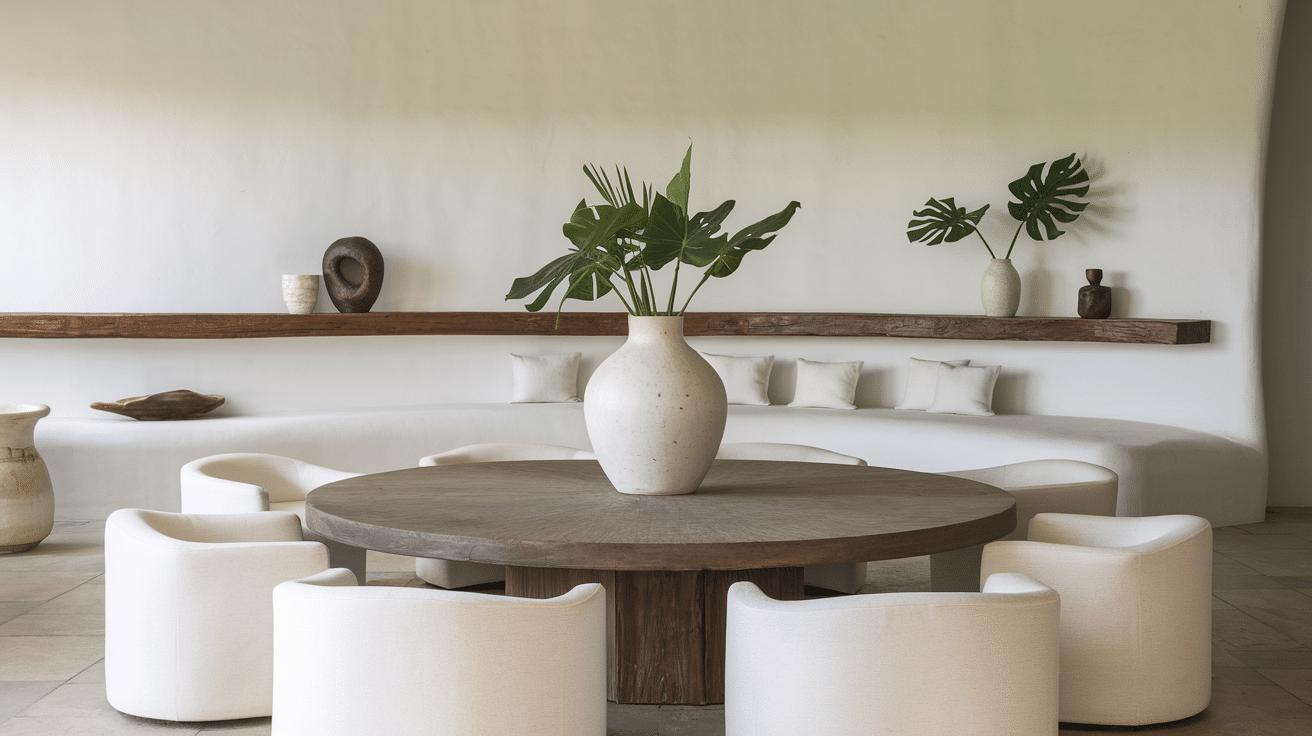Do you feel swamped by stuff? You’re not alone.
Our homes often contain items we rarely use, and our lives are busy with tasks that don’t matter much. This is where organic minimalism steps in.
Organic minimalism brings together two key ideas: less stuff and more nature. It’s about removing what you don’t need and adding natural touches to your space.
People now want both calm homes and earth-friendly choices. This style helps with both.
When you sit in a room with just what you need, plus a few plants and natural materials, something good happens. Your mind feels clearer, and your breathing slows down.
Want to bring this feeling into your own home? Keep reading for simple ideas anyone can use.
What is Organic Minimalism?
Organic minimalism combines two key ideas: keeping things simple and bringing nature indoors. This style removes extra stuff while adding touches from the natural world.
At its heart, this approach strips away what you don’t need. It creates spaces that work well without too many things. But unlike strict minimalism, it adds warmth through natural items.
The goal is to create rooms that feel clean and cozy, places where people can think clearly and feel at ease.
Core Principles of Organic Minimalism
The main idea is to own less but choose better. This means picking fewer items of higher quality, often made from natural sources. Key parts of this style include:
- Fewer items with more open space
- Materials like wood, stone, and plant-based fabrics
- Soft, curved shapes rather than hard edges
- Items that serve a purpose, not just look nice
- Plants that clean the air and add life
- Earth-tone colors that calm the mind
These basics help create rooms that feel both simple and warm. The result is a space where you can truly relax and feel connected to nature.
Key Principles of Organic Minimalism
Organic minimalism combines natural elements with simplified living. These principles help create spaces that feel both peaceful and alive.
1. Embracing Natural Materials
Materials like wood, stone, wool, and linen form the base of organic minimalism. These items feel good to touch and help us feel grounded.
The small flaws in natural items add to their charm, with knots in wood and veins in stone telling a story of time and growth. These imperfections remind us that beauty often comes from small differences, not from being perfect.
2. A Soft, Neutral Color Palette
Colors like beige, light gray, white, and soft green help create calm rooms. These shades don’t fight for our eyes’ focus but instead blend into the background.
Using one color in different shades makes a space feel quiet and ordered, helping our minds rest when we enter the room. This approach to color creates a blank canvas where the textures of natural materials can truly stand out.
3. The Essence of Minimalism with Purpose
Choose items that both look good and work well. A chair should be nice to look at but also nice to sit in. Function matters as much as form in organic minimalism.
Keep spaces free from too many things, but add different textures to make a room feel both clean and cozy. This balance ensures that simplicity never means coldness or lack of comfort.
How to Implement Organic Minimalism in Your Home?
Bringing organic minimalism into your living spaces creates a calm, nature-connected home. Here’s how to apply this style throughout different rooms.
1. Living Room
Create a peaceful living area with simple wood furniture and neutral-toned fabrics that feel both comfortable and functional. Look for clean lines in oak or walnut pieces paired with natural fiber upholstery in soft colors like beige or light gray.
Keep decor minimal with just a few meaningful pieces, such as handcrafted ceramics, woven baskets, or understated wall art featuring natural themes. Each item should earn its place through both beauty and purpose, avoiding visual clutter.
Styling Tips:
- Choose one statement piece rather than many small decorations
- Leave open space on tables and shelves
- Select textured throws and pillows in similar neutral tones
- Arrange furniture to enhance conversation and natural movement
2. Kitchen
Natural stone countertops, such as marble or slate, paired with simple wood cabinets can make your kitchen both beautiful and practical. These materials bring a subtle texture while remaining timeless and durable.
Maximize natural light with minimal window coverings and add pendant lights made from materials like rattan or glass. Keep the space open with only essential items on display, storing others behind clean cabinet fronts.
Styling Tips:
- Install dimmer switches to control light intensity
- Use wooden or ceramic containers for storing essentials
- Choose quality kitchenware in natural materials
- Display fruits or vegetables as natural color accents
3. Bedroom
Transform your bedroom into a true sanctuary with organic cotton or linen bedding in calming, neutral shades. Keep furniture minimal—a simple wooden bed frame, a functional nightstand, and perhaps one comfortable chair is often enough.
Add a connection to nature with a few well-chosen plants near windows and natural textiles like wool throws or linen curtains. The goal is to create a space that helps your mind and body relax completely.
Styling Tips:
- Choose one larger plant rather than many small ones
- Keep bedside tables clear except for essentials
- Layer different textures in similar colors
- Use natural scents like lavender or cedar
4. Bathroom
Stone vanities and earth-toned ceramic tiles create a bathroom that feels like a natural retreat. These materials handle moisture well while maintaining a connection to nature and creating a spa-like experience.
Keep accessories minimal and purposeful—simple cotton towels, wooden bath mats, and perhaps one small plant are enough. Store personal items in matching containers or behind cabinet doors to maintain the clean, tranquil feel.
Styling Tips:
- Use matching containers for toiletries
- Choose natural soaps and products without bright packaging
- Install simple hooks rather than towel bars
- Select plain white towels for a clean spa-like look
Sustainability in Organic Minimalism
Organic minimalism naturally aligns with sustainable living. This approach values quality over quantity and respects our planet’s resources.
Sourcing Sustainable Materials
Sustainable materials form the backbone of truly organic minimalist spaces. Look for reclaimed wood that tells a story through its worn surface and unique character.
This gives new life to old trees without requiring more cutting down. Eco-friendly textiles made from hemp, organic cotton, or linen require fewer chemicals and water to produce than standard options.
When buying new items, look for responsibly sourced materials with proper certifications. These ensure that the product’s journey from raw material to your home didn’t harm people or places.
Energy-Efficiency and Eco-Conscious Design
True organic minimalism extends beyond looks to how a space functions. Passive design elements like proper window placement and natural ventilation reduce the need for heating and cooling.
This cuts energy use while making rooms feel more connected to nature’s rhythms. Adding features like solar panels, LED lighting, and smart thermostats further reduces your home’s footprint.
Water-saving systems, such as low-flow fixtures and rainwater collection tanks, help protect this vital resource. These practical choices work perfectly with the organic minimalist style, which values function as much as form.
Final Thoughts
When you strip away what doesn’t matter, you find what does. This is the heart of organic minimalism.
Your home becomes more than just a place to keep stuff. It turns into a space that helps you breathe, think, and feel better. The natural materials age with grace, and the simple design stays relevant year after year.
By choosing this path, you create rooms that work with nature, not against it. You build spaces that feel good today and will still feel good tomorrow.
Organic minimalism isn’t about following rules. It’s about finding your own balance of simplicity and warmth and making choices that benefit both you and the planet.
In the end, isn’t that what makes a house truly feel like home?
Frequently Asked Questions (FAQs)
What is the Organic Modern Style?
Organic modern style blends minimalism with natural elements. It uses clean lines, natural materials, and neutral colors to create warm, uncluttered spaces that feel connected to nature.
Is Organic Modern Timeless?
Yes, organic modern is timeless. Its focus on natural materials, simple forms, and neutral colors means it stays relevant across trends, unlike styles that quickly look dated.














